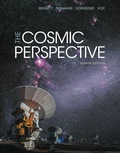
EBK COSMIC PERSPECTIVE, THE
8th Edition
ISBN: 8220101465108
Author: Voit
Publisher: PEARSON
expand_more
expand_more
format_list_bulleted
Concept explainers
Textbook Question
Chapter 6, Problem 2EAP
How does a camera record light? How are images affected by exposure time? What are pixels?
Expert Solution & Answer
Want to see the full answer?
Check out a sample textbook solution
Students have asked these similar questions
No chatgpt pls will upvote
No chatgpt pls will upvote
No chatgpt pls will upvote
Chapter 6 Solutions
EBK COSMIC PERSPECTIVE, THE
Ch. 6 - Prob. 1VSCCh. 6 - Prob. 2VSCCh. 6 - Prob. 3VSCCh. 6 - Prob. 4VSCCh. 6 - Prob. 5VSCCh. 6 - How does your eye focus light? How is a glass lens...Ch. 6 - How does a camera record light? How are images...Ch. 6 - What are the two key properties of a telescope,...Ch. 6 - What is the diffraction limit, and how does it...Ch. 6 - How do reflecting telescopes differ from...
Ch. 6 - What are the three basic categories of...Ch. 6 - Prob. 7EAPCh. 6 - What do we mean by spectral resolution? Why is...Ch. 6 - List at least three ways in which Earth's...Ch. 6 - 10. Describe how deeply each portion of the...Ch. 6 - Prob. 11EAPCh. 6 - Prob. 12EAPCh. 6 - Prob. 13EAPCh. 6 - Prob. 14EAPCh. 6 - Prob. 15EAPCh. 6 - Prob. 16EAPCh. 6 - Prob. 17EAPCh. 6 - Prob. 18EAPCh. 6 - Prob. 19EAPCh. 6 - Prob. 20EAPCh. 6 - Prob. 21EAPCh. 6 - Prob. 22EAPCh. 6 - Prob. 23EAPCh. 6 - Prob. 24EAPCh. 6 - Prob. 25EAPCh. 6 - Prob. 26EAPCh. 6 - Prob. 27EAPCh. 6 - Prob. 28EAPCh. 6 - Prob. 29EAPCh. 6 - Prob. 30EAPCh. 6 - Prob. 31EAPCh. 6 - Prob. 32EAPCh. 6 - Prob. 33EAPCh. 6 - Prob. 34EAPCh. 6 - Prob. 35EAPCh. 6 - Prob. 36EAPCh. 6 - Prob. 37EAPCh. 6 - Prob. 38EAPCh. 6 - Prob. 39EAPCh. 6 - Prob. 40EAPCh. 6 - Prob. 41EAPCh. 6 - Prob. 42EAPCh. 6 - Prob. 43EAPCh. 6 - Prob. 44EAPCh. 6 - Prob. 45EAPCh. 6 - Prob. 46EAPCh. 6 - Prob. 47EAPCh. 6 - Prob. 48EAPCh. 6 - Prob. 49EAPCh. 6 - Prob. 50EAPCh. 6 - Prob. 51EAPCh. 6 - Prob. 52EAPCh. 6 - 53. Major Ground-Based Observatories. Take a...Ch. 6 - Prob. 54EAPCh. 6 - Prob. 55EAP
Knowledge Booster
Learn more about
Need a deep-dive on the concept behind this application? Look no further. Learn more about this topic, physics and related others by exploring similar questions and additional content below.Similar questions
- No chatgpt plsarrow_forwardhelp me with the experimental set up for the excel i did. the grapharrow_forwardWhich of the following best describes how to calculate the average acceleration of any object? Average acceleration is always halfway between the initial acceleration of an object and its final acceleration. Average acceleration is always equal to the change in velocity of an object divided by the time interval. Average acceleration is always equal to the displacement of an object divided by the time interval. Average acceleration is always equal to the change in speed of an object divided by the time interval.arrow_forward
- The figure shows the velocity versus time graph for a car driving on a straight road. Which of the following best describes the acceleration of the car? v (m/s) t(s) The acceleration of the car is negative and decreasing. The acceleration of the car is constant. The acceleration of the car is positive and increasing. The acceleration of the car is positive and decreasing. The acceleration of the car is negative and increasing.arrow_forwardWhich figure could represent the velocity versus time graph of a motorcycle whose speed is increasing? v (m/s) v (m/s) t(s) t(s)arrow_forwardUnlike speed, velocity is a the statement? Poisition. Direction. Vector. Scalar. quantity. Which one of the following completesarrow_forward
- No chatgpt pls will upvote Already got wrong chatgpt answerarrow_forward3.63 • Leaping the River II. A physics professor did daredevil stunts in his spare time. His last stunt was an attempt to jump across a river on a motorcycle (Fig. P3.63). The takeoff ramp was inclined at 53.0°, the river was 40.0 m wide, and the far bank was 15.0 m lower than the top of the ramp. The river itself was 100 m below the ramp. Ignore air resistance. (a) What should his speed have been at the top of the ramp to have just made it to the edge of the far bank? (b) If his speed was only half the value found in part (a), where did he land? Figure P3.63 53.0° 100 m 40.0 m→ 15.0 marrow_forwardPlease solve and answer the question correctly please. Thank you!!arrow_forward
arrow_back_ios
SEE MORE QUESTIONS
arrow_forward_ios
Recommended textbooks for you
 Principles of Physics: A Calculus-Based TextPhysicsISBN:9781133104261Author:Raymond A. Serway, John W. JewettPublisher:Cengage Learning
Principles of Physics: A Calculus-Based TextPhysicsISBN:9781133104261Author:Raymond A. Serway, John W. JewettPublisher:Cengage Learning Physics for Scientists and Engineers: Foundations...PhysicsISBN:9781133939146Author:Katz, Debora M.Publisher:Cengage Learning
Physics for Scientists and Engineers: Foundations...PhysicsISBN:9781133939146Author:Katz, Debora M.Publisher:Cengage Learning College PhysicsPhysicsISBN:9781938168000Author:Paul Peter Urone, Roger HinrichsPublisher:OpenStax College
College PhysicsPhysicsISBN:9781938168000Author:Paul Peter Urone, Roger HinrichsPublisher:OpenStax College University Physics Volume 3PhysicsISBN:9781938168185Author:William Moebs, Jeff SannyPublisher:OpenStax
University Physics Volume 3PhysicsISBN:9781938168185Author:William Moebs, Jeff SannyPublisher:OpenStax Glencoe Physics: Principles and Problems, Student...PhysicsISBN:9780078807213Author:Paul W. ZitzewitzPublisher:Glencoe/McGraw-Hill
Glencoe Physics: Principles and Problems, Student...PhysicsISBN:9780078807213Author:Paul W. ZitzewitzPublisher:Glencoe/McGraw-Hill Physics for Scientists and Engineers with Modern ...PhysicsISBN:9781337553292Author:Raymond A. Serway, John W. JewettPublisher:Cengage Learning
Physics for Scientists and Engineers with Modern ...PhysicsISBN:9781337553292Author:Raymond A. Serway, John W. JewettPublisher:Cengage Learning

Principles of Physics: A Calculus-Based Text
Physics
ISBN:9781133104261
Author:Raymond A. Serway, John W. Jewett
Publisher:Cengage Learning

Physics for Scientists and Engineers: Foundations...
Physics
ISBN:9781133939146
Author:Katz, Debora M.
Publisher:Cengage Learning

College Physics
Physics
ISBN:9781938168000
Author:Paul Peter Urone, Roger Hinrichs
Publisher:OpenStax College

University Physics Volume 3
Physics
ISBN:9781938168185
Author:William Moebs, Jeff Sanny
Publisher:OpenStax

Glencoe Physics: Principles and Problems, Student...
Physics
ISBN:9780078807213
Author:Paul W. Zitzewitz
Publisher:Glencoe/McGraw-Hill

Physics for Scientists and Engineers with Modern ...
Physics
ISBN:9781337553292
Author:Raymond A. Serway, John W. Jewett
Publisher:Cengage Learning
Convex and Concave Lenses; Author: Manocha Academy;https://www.youtube.com/watch?v=CJ6aB5ULqa0;License: Standard YouTube License, CC-BY